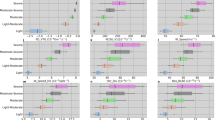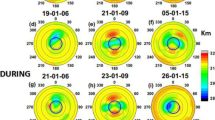Abstract
The Wuhan meteor radar is the first all-sky meteor radar in China. The circulation near the mesopause from February to September 2002 is studied based on the data obtained by the Wuhan meteor radar. The zonal wind is usually eastward in winter from 80 to 100 km. The mean zonal wind become westward from March to early of May, when the winter circulation reverses to the summer circulation. But at the meteor heights, the zonal circulation usually becomes eastward after the middle of May. The meridional circulation is always equatorward. The peaks of the meridional wind move downward with the height, and the peak value reaches its maximum of 21 ms−1 in July. Having made a comparison between monthly mean wind and HWM93 model wind, the value of southward wind, the maximal value of eastward wind as well as the reversal height of zonal wind are found to be quite different from each other.
Similar content being viewed by others
References
Hocking, W. K., Fuller, B., Vandepeer, B., Real-time determination of meteor-related parameters utilizing modern digital technology, J. Atmos. Solar-Terr. Phys., 2001, 63(2/3): 155–169.
Forbes, J. M., MST radar detection of middle atmosphere tides, Radio Sci., 1985, 20(6): 1435–1440.
Jocobi, Ch., Portnyagin, Yu. I., Merzlyakov, E. G. et al., Mesosphere/lower thermosphere wind measurements over Europe in summer 1998, J. Atmos. Solar Ter. Phys., 2001, 63(10): 1017–1031.
Singer, W., Hoffmann, P., Manson, A. H. et al., The wind regime of the mesosphere and lower thermosphere during the DYANA campaign, I. Prevailing winds. J. Atmos. Terr. Phys., 1994, 56(14): 1717–1729.
Tsuda, T., Nakamura, T., Kato, S., Mean winds observed by the Kyoto meteor radar in 1983–1985, J. Atmos. Terr. Phys., 1987, 49(5): 461–466.
Marsh, S. H., Bennett, R. G. T., Baggaley, W. J. et al., Measuring meridional mesospheric winds with the AMOR meteor radar. J. Atmos. Solar-Terr. Phys., 2000, 62(13): 1129–1133.
Hedin, A. E., Fleming, E. L., Manson, A. H. et al., Empirical wind models for the upper, middle and lower atmosphere. J. Atmos. Terr. Phys., 1996, 58(15): 1421–1447.
Clark, R. R., Upper atmosphere wind observations of waves and tides with UNH Meteor Radar System at Durham 43°N (1977, 1978 and 1979), J. Atmos. Terr. Phys., 1983, 45(8/9): 621–627.
Manson, A. H., Meek, C. E., Middle atmosphere (60–110 km) tidal oscillations at Saskatoon during 1983–1984. Radio Science, 20(6): 1441–1451.
Hock, K., Igarashi, K., Mean winds in the mesopause region observed by MF radars at 31° and 45° N, J. Atmos. Solar-Terr. Phys., 1998, 60(11): 1081–1087.
Schminder, R., Kurschner, D., Singer, W. et al., Representative height-time cross-sections of the upper atmosphere wind field over Centeral Europe 1990–1996, J. Atmos. Solar-Terr. Phys., 1997, 59(17): 2177–2184.
Author information
Authors and Affiliations
Corresponding author
About this article
Cite this article
Xiong, J., Wan, W., Ning, B. et al. Meteor radar observation of circulation near mesopause over Wuhan. Chin. Sci. Bull. 48, 1634–1638 (2003). https://doi.org/10.1007/BF03183974
Received:
Issue Date:
DOI: https://doi.org/10.1007/BF03183974




